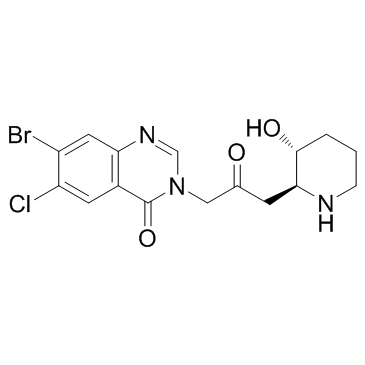Halofuginone (RU-19110) |
| Catalog No.GC31650 |
La halofuginona (RU-19110) (RU-19110), un derivado de la febrifugina, es un inhibidor competitivo de la prolil-tRNA sintetasa con una Ki de 18,3 nM.
Products are for research use only. Not for human use. We do not sell to patients.

Cas No.: 55837-20-2
Sample solution is provided at 25 µL, 10mM.
Halofuginone (RU-19110) is a less-toxic form of Febrifugine, which is isolated from the plant Dichroa febrifuga[1]. Halofuginone inhibits prolyl-tRNA synthetase in an ATP-dependent manner with a Ki of 18.3 nM[2]. Halofuginone attenuates osteoarthritis (OA) by inhibition of TGF-β activity[3].
Halofuginone competitively inhibits prolyl-tRNA synthetase by occupying both the prolineand tRNA-binding pockets of prolyl-tRNA synthetase[1]. The IC50 of Halofuginone is 114.6 and 58.9 nM in KYSE70 and A549 cells. The IC50s of Halofuginone for NRF2 are 22.3 and 37.2 nM in KYSE70 and A549 cells, respectively. The IC50 of Halofuginone for global protein synthesis is 22.6 and 45.7 nM in KYSE70 and A549 cells, respectively[1]. The amount of NRF2 protein is significantly decreased in the presence of Halofuginone in both the KYSE70 and A549 cell lines. NRF2 mRNA levels are not decreased, but rather are increased after application of Halofuginone to both KYSE70 and A549 cells, indicating that Halofuginone acts to decrease NRF2 protein expression at the post-transcriptional level. Time-course studies show that Halofuginone decreases NRF2 protein expression in KYSE70 and A549 cells within 12 hours of treatment[1].
Halofuginone attenuates progression of OA in anterior cruciate ligament transection (ACLT) mice. The optimal dose (1 mg/kg body weight) is identified using multiple concentrations of HF (0.2, 0.5, 1 or 2.5 mg/kg) injected every other day for 1 month post surgery. Lower concentration (0.2 or 0.5 mg/kg) has minimal effects on subchondral bone and higher concentration (2.5 mg/kg) induces proteoglycan loss in articular cartilage[3]. Halofuginone (0.25-mg/kg, intraperitoneally) decreases NRF2 protein levels in tumors. While the tumor volumes do not change substantially between treatments with the vehicle, Halofuginone(0.25 mg/kg, intraperitoneally injected, every day) or cisplatin alone, combined treatment with Halofuginone and Cisplatin significantly suppresses the tumor volume compared to treatment with Halofuginone or cisplatin alone[1].
[1]. Tsuchida K, et al. Halofuginone enhances the chemo-sensitivity of cancer cells by suppressing NRF2 accumulation. Free Radic Biol Med. 2017 Feb;103:236-247. [2]. Keller TL, et al. Halofuginone and other Febrifugine derivatives inhibit prolyl-tRNA synthetase. Nat Chem Biol. 2012 Feb 12;8(3):311-7. [3]. Cui Z, et al. Halofuginone attenuates osteoarthritis by inhibition of TGF-β activity and H-type vessel formation in subchondral bone. Ann Rheum Dis. 2016 Sep;75(9):1714-21.
Average Rating: 5 (Based on Reviews and 34 reference(s) in Google Scholar.)
GLPBIO products are for RESEARCH USE ONLY. Please make sure your review or question is research based.
Required fields are marked with *




